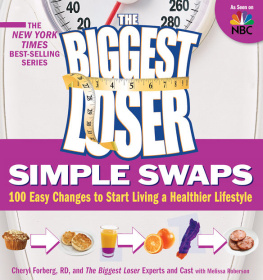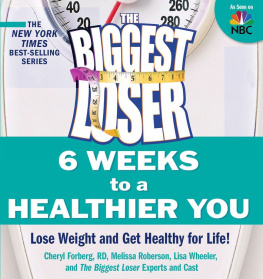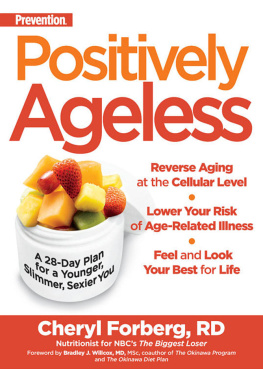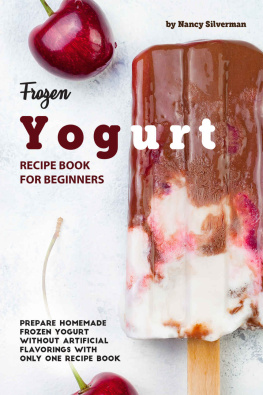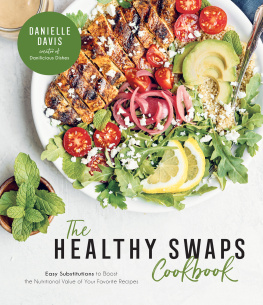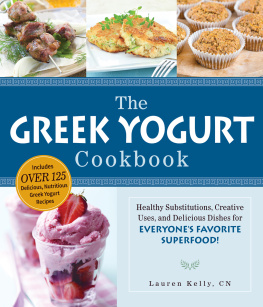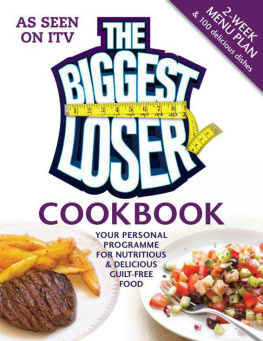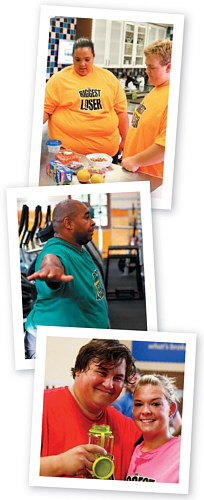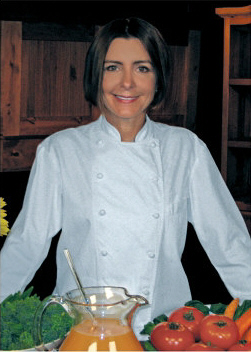Production Development and Direction:
Chad Bennett, Dave Broome, Cindy Chang, Neysa Gordon, Mark Koops, Todd Nelson, Kim Niemi, J. D. Roth, Ben Silverman
NBCU, Reveille, 25/7 Productions, and 3Ball Productions would like to thank the many people who gave their time and energy to this project:
Jenna Alifante, Dave Altarescu, Stephen Andrade, Carole Angelo, Dana Arnett, Sebastian Attie, Nancy Bailey, The BiggestLoser contestants, Dave Bjerke, Maria Bohe, Jessa Bouso, Jen Busch, Joni Camacho, Jill Carmen, Scot Chastain, Hope Clarke, Ben Cohen, Jason Cooper, Steve Coulter, Dan Curran, Dr. Michael Dansinger, Camilla Dhanak, Jenny Ellis, Kat Elmore, John Farrell, Cheryl Forberg, Jeff Friedman, Jeff Gaspin, Christina Gaugler, Marc Graboff, Graham Greenlee, Bob Harper, Chris Harris, Robyn Hennessey, Shelli Hill, Dr. Robert Huizenga, Jill Jarosz, Helen Jorda, Adam Kaloustian, Alex Katz, Allison Kaz, Loretta Kraft, Chris Krogermeier, Laura Kuhn, Beth Lamb, Todd Lubin, Roni Lubliner, Alan Lundgren, Carole MacDonal, Rebecca Marks, Joaquin Mesa, Jillian Michaels, Gregg Michaelson, John Miller, Ann Morteo, Kam Naderi, Gabriela Navarro, Julie Nugent, Trae Patton, Jerry Petry, Ellie Prezant, Ed Prince, Lee Rierson, Karen Rinaldi, Melissa Roberson, Beth Roberts, Maria Rodale, Jessica Roth, Joe Schlosser, Leslie Schwartz, Robin Shallow, Carrie Simons, Mitch Steele, Lee Straus, Kelia Tardiff, Paul Teledgy, Deborah Thomas, Julie True, Liza Whitcraft, Julie Will, Yong Yam, Jeff Zucker

W hen I opened my newspaper on a recent morning, I read something that shocked me: Over the past year, our obesity rates did not decrease in any state in America. Its hard for me to believe, because as the nutritionist for The Biggest Loser, I see and hear so many weight-loss success stories every dayand not just from contestants, but from viewers as well.
I first meet the contestants at the start of each new season of the show, when they sit down with me for a comprehensive nutrition consultation. During these meetings, I have the opportunity to learn about each individuals unique history and struggles, including their typical eating habits and their past attempts to lose weight. Whats interesting is that no matter how different each persons story is, almost all of them share many of the same issues. By now, I can almost predict some of the answers Ill receive to the questions I ask.
After eight wonderful seasons with the show, Ive learned a lot about the common difficulties and obstacles many Americans face when it comes to their eating habits and attempts at weight management. Among these issues, Ive identified 10 key factors that I believe play a vital role in weight gain and poor overall health. Ive found that most of our contestants:
- Had absolutely no idea how many calories their bodies really needed (or how many they consumed each day).
- Frequently skipped breakfast and other meals.
- Didnt eat enough fruits or vegetables.
- Didnt eat enough lean protein.
- Didnt eat enough whole grains.
- Ate too much white stuff, such as white flour, white pasta, white sugar, white rice, and simple carbohydrates.
- Didnt plan their meals in advance and often found themselves grabbing something on the go, which they ate standing up, in the car, or at their desks.
- Drank too many of their calories (some people consumed their daily calorie budgets in sugary drinks alone!) but didnt drink enough water or milk.
- Didnt get enough exercise (if any).
- Prioritized other thingssuch as their families, friends, and jobsover their own health and wellbeing.
If youre trying to lose weight, youre probably all too familiar with many of these challenges. This book provides the tools you need to get started on your own transformation. A lot of people are afraid that creating a healthier lifestyle will be too hard or too expensive or that it will require too much time and effort. The idea behind Simple Swaps is to make getting healthy a less daunting challenge. Living a healthier life doesnt mean you have to change everything at onceit begins with small, manageable steps. A good place to start is to swap some of your daily habits and choices for healthier versions. For example, you might swap your daily glass of fruit juice for a piece of whole fruit, or swap your sweet afternoon treat from the coffee shop for a satisfying snack that combines protein and carbohydrates to give you a boost of energy.
I created 100 Simple Swaps and more than 30 mouthwatering recipes for this book based on my experience and success with The Biggest Loser contestants and the common struggles most people face when it comes to weight loss. Many of these recommendations are the same ones I give the contestants when they come to see me on that first day at The Biggest Loser ranch. Throughout the book, youll find not only my recommendations and advice, but tips from the contestants themselves, who know firsthand how tough it can be to fit lifestyle changes into a busy schedule, and who have incorporated these swaps into their weight-loss efforts.
Whether youre looking to shed just a few pounds, lose a significant amount of weight, or simply maintain a healthy weight, these Simple Swaps will not only help you keep fit, but also ensure that youre getting the nutrients you need for optimal health and wellness. Swapping one unhealthy food, habit, or lifestyle choice for another, better one is where it all begins.
I n my seven seasons with the show, I quickly learned that our contestants, like most other Americans, are very busy people. With that in mind, most of the Simple Swap recipes are fairly easy to prepare. There arent too many fancy ingredients or expensive kitchen tools to buy. However, portion size is always key to staying within your calorie budget, so measuring tools are a must. They include liquid measuring cups, dry measuring cups, measuring spoons, and a food scale (see Chapter 2 for more details).
Here are a few of my other must-have kitchen tools.
Tools
Squeeze bottles I love to keep a variety of squeeze bottles on hand in the kitchen. Not only do they allow you to aim, shoot, and squeeze small amounts of sauces or dressings into a pretty design on your plate (instead of pouring out a big glob), but the narrower the opening, the slower the pour, meaning that you use less dressing or sauce. And a smaller amount translates into fewer calories. I even like to put purchased bottled dressings and sauces into squeeze bottles, because they deliver a much smaller portion and theyre so easy to use.
Spray bottles Cooking oil spray is used throughout this book to minimize use of added fat. Rather than using aerosolized cans, I recommend purchasing an oil spray bottle, which you can find in most health food stores. Fill it with your own fresh oils as needed. For regular baking and sauting, fill the spray bottle with a mild-flavored oil. Cooking oils can be stored in a cool, dark place for up to 4 months. Because they are composed of highly unsaturated fats, they will turn rancid within several months after opening. Buying a large bottle with a great price tag is not the best option, since youll be adding less oil to your cooking. When in doubt of your oils freshness, throw it out and open a fresh bottle. One tablespoon of rancid oil can ruin the flavor of an entire recipe.

